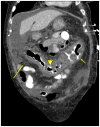Immune responses to Clostridium difficile infection
- PMID: 23084763
- PMCID: PMC3500589
- DOI: 10.1016/j.molmed.2012.09.005
Immune responses to Clostridium difficile infection
Abstract
Clostridium difficile is the causal agent of antibiotic-associated diarrhea and is a leading cause of hospital-acquired infections in the US. C. difficile has been known to cause severe diarrhea and colitis for more than 30 years, but the emergence of a newer, hypervirulent strain of C. difficile (BI/NAP1) has further compounded the problem, and recently both the number of cases and mortality associated with C. difficile-associated diarrhea have been increasing. One of the major drivers of disease pathogenesis is believed to be an excessive host inflammatory response. A better understanding of the host inflammation and immune mechanisms that modulate the course of disease and control host susceptibility to C. difficile could lead to novel (host-targeted) strategies for combating the challenges posed by this deadly infection. This review summarizes our current knowledge of the host inflammatory response during C. difficile infection.
Copyright © 2012 Elsevier Ltd. All rights reserved.
Figures


Similar articles
-
The microbiota and immune response during Clostridium difficile infection.Anaerobe. 2016 Oct;41:79-84. doi: 10.1016/j.anaerobe.2016.05.009. Epub 2016 May 20. Anaerobe. 2016. PMID: 27212111 Free PMC article. Review.
-
Role of microbiota and innate immunity in recurrent Clostridium difficile infection.J Immunol Res. 2014;2014:462740. doi: 10.1155/2014/462740. Epub 2014 Jun 5. J Immunol Res. 2014. PMID: 24995345 Free PMC article. Review.
-
IL-33 drives group 2 innate lymphoid cell-mediated protection during Clostridium difficile infection.Nat Commun. 2019 Jun 20;10(1):2712. doi: 10.1038/s41467-019-10733-9. Nat Commun. 2019. PMID: 31221971 Free PMC article.
-
The roles of host and pathogen factors and the innate immune response in the pathogenesis of Clostridium difficile infection.Mol Immunol. 2015 Feb;63(2):193-202. doi: 10.1016/j.molimm.2014.09.005. Epub 2014 Sep 18. Mol Immunol. 2015. PMID: 25242213 Free PMC article. Review.
-
Immune responses induced by Clostridium difficile.Anaerobe. 2016 Oct;41:68-78. doi: 10.1016/j.anaerobe.2016.04.014. Epub 2016 Apr 21. Anaerobe. 2016. PMID: 27108093 Review.
Cited by
-
Clostridium difficile colitis: pathogenesis and host defence.Nat Rev Microbiol. 2016 Oct;14(10):609-20. doi: 10.1038/nrmicro.2016.108. Epub 2016 Aug 30. Nat Rev Microbiol. 2016. PMID: 27573580 Free PMC article. Review.
-
The microbiota and immune response during Clostridium difficile infection.Anaerobe. 2016 Oct;41:79-84. doi: 10.1016/j.anaerobe.2016.05.009. Epub 2016 May 20. Anaerobe. 2016. PMID: 27212111 Free PMC article. Review.
-
Bacteriophages are more virulent to bacteria with human cells than they are in bacterial culture; insights from HT-29 cells.Sci Rep. 2018 Mar 23;8(1):5091. doi: 10.1038/s41598-018-23418-y. Sci Rep. 2018. PMID: 29572482 Free PMC article.
-
Clostridium difficile-induced colitis in mice is independent of leukotrienes.Anaerobe. 2014 Dec;30:90-8. doi: 10.1016/j.anaerobe.2014.09.006. Epub 2014 Sep 16. Anaerobe. 2014. PMID: 25230329 Free PMC article.
-
Role of microbiota and innate immunity in recurrent Clostridium difficile infection.J Immunol Res. 2014;2014:462740. doi: 10.1155/2014/462740. Epub 2014 Jun 5. J Immunol Res. 2014. PMID: 24995345 Free PMC article. Review.
References
-
- Hall ICOTE. Intestinal flora in new-born infants: with a description of a new pathogenic anaerobe, Bacillus difficilis. American Journal of Diseases of Children. 1935;49:390–402.
-
- Bartlett JG, Chang TW, Gurwith M, Gorbach SL, Onderdonk AB. Antibiotic-associated pseudomembranous colitis due to toxin-producing clostridia. N Engl J Med. 1978;298:531–4. - PubMed
-
- Bartlett JG, Moon N, Chang TW, Taylor N, Onderdonk AB. Role of Clostridium difficile in antibiotic-associated pseudomembranous colitis. Gastroenterology. 1978;75:778–82. - PubMed
-
- Miller BA, Chen LF, Sexton DJ, Anderson DJ. Comparison of the burdens of hospital-onset, healthcare facility-associated Clostridium difficile Infection and of healthcare-associated infection due to methicillin-resistant Staphylococcus aureus in community hospitals. Infect Control Hosp Epidemiol. 2011;32:387–90. - PubMed
Publication types
MeSH terms
Substances
Grants and funding
LinkOut - more resources
Full Text Sources
Medical

